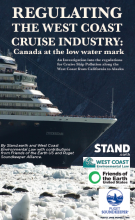
While the COVID-19 pandemic has been a once-in-a-century global tragedy, one of its unforeseen impacts was a welcome reprieve for marine and coastal ecosystems from the massive amount of cruise ship pollution that is discharged off the Pacific Coast of Canada each year. That reprieve may soon come to an end as Carnival Corporation and other cruise companies are preparing to return to business-as-usual. If the next cruise season is anything like 2019, more than a million passengers will arrive on dozens of voyages through the waters off BC on their way to and from Alaska, leaving in their wake more than 31 billion litres of inadequately treated cruise ship pollution laden with fecal coliform, ammonia, heavy metals and polycyclic aromatic hydrocarbons – pollutants that are harmful to human health, aquatic organisms and coastal ecosystems.
Canada’s cruise ship pollution regulations have lagged behind the regulations in other places. When the federal government adopted the Vessel Pollution and Dangerous Chemicals (VPDC) Regulations in 2012, they were already the weakest protections against cruise ship pollution on the West Coast of North America from California to Alaska. Neighboring jurisdictions in Washington State and Alaska had recognized the threat of a rapidly expanding cruise ship industry more than a decade earlier, and passed a suite of laws and regulations that held cruise ship operators accountable for the vast amounts of water pollution these floating cities create on their voyages up and down the West Coast.
But even these regulatory regimes need to be updated to deal with a relatively new source of pollution: scrubber washwater. Vast quantities of washwater are deposited in ocean waters in an attempt to remove sulfur dioxides from the heavy fuel oil combustion exhaust pouring from cruise ship smokestacks. Washwater may sound benign, but it is full of heavy metals and organic compounds that threaten human health and aquatic ecosystems.
If Canada is going to lift restrictions and allow cruise ships to return in the post-pandemic era, the federal government must act now to improve the laws and regulations that protect coastal waters from massive amounts of cruise ship pollution.
As this report illustrates, our coastal neighbors have led the way so far. The unique nature of Pacific coastal waterways and the sensitivity of these aquatic ecosystems call for even stronger protections before the cruise industry attempts to start up where it left off in 2019.
This report was produced by Stand.earth and West Coast Environmental Law with contributions from Friends of the Earth US and Puget Soundkeeper Alliance.